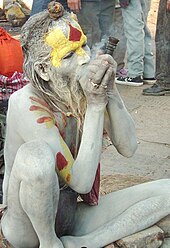Shivaratri


Shivaratri or Mahashivaratri , the night of Shiva , is an important holiday in Hinduism . For the worshipers of the god Shiva it is the highest festival, the holiest of all nights. According to the Hindu calendar, the holiday takes place on the 14th day of the month Phalguna , according to the modern calendar at the end of February / beginning of March.
A particularly significant form of the absolute in the Hindu world of gods is Shiva, whose name also means "the benevolent" or "the blessing". While the formless Brahman is embodied again and again in the form of Vishnu according to the Hindu view and appears in many manifestations, the writings of Shiva expressly emphasize the formlessness. In the Trimurti , the Hindu Trinity , he has the task of annihilation, while Brahma is the creator and Vishnu is the one who sustains the universe. As a destroyer, Shiva points out impermanence: Everything created must perish! Just like his feminine side, Kali , he is also Kala , the time that allows everything to arise - without mercy, but also destroyed again. But he, the ultimately formless, contains all aspects of the divine, and that is why the believers also see him as the savior: as Nilakhanta, for example, he saves the world from its destruction by drinking the poison of the mythical primeval sea .
Although also depicted personally, in pictures or sculptures, the believer is always aware of Shiva's formlessness: the focus of worship is usually a linga or one of his attributes, such as a trident. Lingam literally means "sign". In India , it is common since prehistoric times and Shiva is worshiped today in it. It is considered the purest symbol of the absolute.
Lingas that arise spontaneously in nature are often worshiped. A well-known example is in an ice cave in Amarnath in the Himalayas , where an Eislinga grows regularly with the waxing moon and shrinks as the moon wanes. Here is an important Hindu pilgrimage site . Every year at Shivaratri, a particularly large number of believers make the arduous journey up to the mountains of the Himalayas to worship Shiva in the pillar of ice. But also other mountains in India such as Mount Girnar in Gujarat and other sanctuaries such as the places where Jyotirlingas are, are the destination of pilgrims on this holiday , who often undertake voluntary exertions and travel as an exercise of penance under particularly difficult conditions.
At Shivaratri the focus is less on the destructive aspect of Shiva, but primarily on that of the Savior. While Vishnu is the Supreme for Vishnu traditions, Shivaites see Shiva as a manifestation of the Supreme. A very popular story from the Puranas tells:
- Brahma and Vishnu were arguing about who was the highest of them when a shining linga appeared before them like a pillar of fire. Since neither could discover the beginning nor the end, they paid tribute to Shiva as the Most High. He stepped out of the pillar of fire and said: "Whoever fasts in the future, keeps vigil and worships me, will be freed from all sins and redeemed" .
The aspect of Shiva as savior and the forgiveness of sins play a decisive role on this holiday, as countless stories have passed down. Many believers watch this holy night, pray and sing together, as the Divine himself demands in the scriptures:
- "On the fourteenth night of the dark half of the month, I will walk the earth in Kali-Yuga (the present age ). I will most certainly be in all lingas, both mobile and immobile, to take away the sins that human beings have in the past year; therefore whoever worships me with mantras that night will be free from sin " . (Nagar Khanda)
Hindus of all traditions celebrate this day with fasting, watching through the night and with prayers; women especially fast and seek blessings for their husbands. Those who cannot take part in a pilgrimage visit the nearest temple or celebrate worship at home. Believers ritually pour water, milk, yoghurt, butter and honey over a linga and decorate it with the leaves of a sacred tree, the bel (also called the bheel).
Web links
- Shivaratri - photos, videos and information (Yogawiki article)
